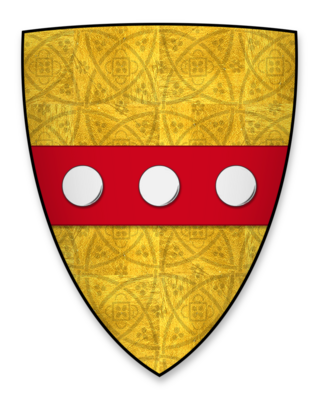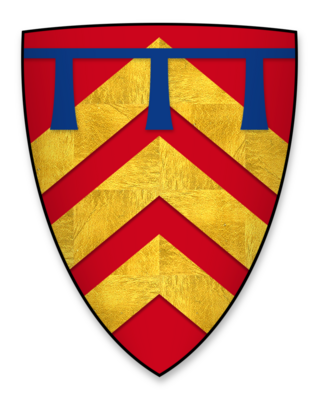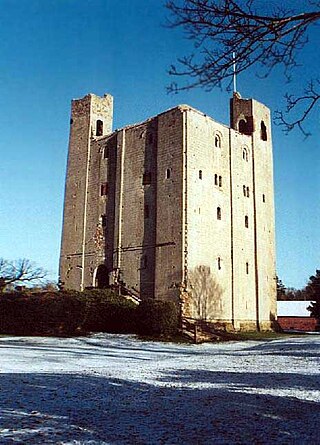
Magna Carta Libertatum, commonly called Magna Carta or sometimes Magna Charta, is a royal charter of rights agreed to by King John of England at Runnymede, near Windsor, on 15 June 1215. First drafted by the Archbishop of Canterbury, Cardinal Stephen Langton, to make peace between the unpopular king and a group of rebel barons, it promised the protection of church rights, protection for the barons from illegal imprisonment, access to swift and impartial justice, and limitations on feudal payments to the Crown, to be implemented through a council of 25 barons. Neither side stood by their commitments, and the charter was annulled by Pope Innocent III, leading to the First Barons' War.

Henry de Bohun, 1st Earl of Hereford of Pleshey Castle in Essex, was an Anglo-Norman nobleman who became Hereditary Constable of England from 1199.

Gilbert de Clare, 4th Earl of Hertford, 5th Earl of Gloucester, 1st Lord of Glamorgan, 7th Lord of Clare was the son of Richard de Clare, 3rd Earl of Hertford (c. 1153–1217), from whom he inherited the Clare estates. He also inherited from his mother, Amice Fitz William, the estates of Gloucester and the honour of St. Hilary, and from Rohese, an ancestor, the moiety of the Giffard estates. In June 1202, he was entrusted with the lands of Harfleur and Montrevillers.
Elizabeth de Mowbray, Duchess of Norfolk was an English noblewoman and the wife of Thomas Mowbray, 1st Duke of Norfolk.

The House of Mowbray was an Anglo-Norman noble house, derived from Montbray in Normandy and founded by Roger de Mowbray, son of Nigel d'Aubigny.
Robert Fitz Richard (1064–1136) was an Anglo-Norman feudal baron of Little Dunmow, Essex and constable of Baynard's Castle in the City of London. His feudal barony, the caput of which was at Little Dunmow in Essex, was granted to him by the king after it had been forfeited in 1110 by William Baynard, whose grandfather Ralph Baynard was the first holder and the builder of Baynard's Castle in the City of London.

Reginald West, 6th Baron De La Warr and 3rd Baron West was an English nobleman and politician.

Thomas West, 1st Baron West was an English nobleman and member of parliament.
John (II) de Mowbray, 3rd Baron Mowbray was the only son of John de Mowbray, 2nd Baron Mowbray, by his first wife, Aline de Brewes, daughter of William de Braose, 2nd Baron Braose. He was born in Hovingham, Yorkshire.

John (III) de Mowbray, 4th Baron Mowbray was an English peer. He was slain near Constantinople while en route to the Holy Land.

John (IV) de Mowbray, 1st Earl of Nottingham, 5th Baron Mowbray, 6th Baron Segrave, was an English peer.

William of Huntingfield was a medieval English baron, Sheriff of Norfolk and Suffolk and one of the sureties of Magna Carta.

Richard de Montfichet was a Magna Carta surety. He was a landowner in Essex.
William Grey was Bishop of London and then Bishop of Lincoln.
The Baronial Order of Magna Charta ("BOMC") is a scholarly, charitable, and lineage society founded in 1898. The BOMC was originally named the Baronial Order of Runnemede, but the name was subsequently changed to better reflect the organization's purposes relating to the Magna Charta and the promulgation of "freedom of man under the rule of law."

John FitzRobert is listed as one of the Surety Barons for Magna Carta (1215), although it seems not previously noted as a rebel. He was the son of Robert fitzRoger and Margaret Chesney.
Eleanor de Mowbray was the daughter of John de Mowbray, 4th Baron Mowbray, and Elizabeth de Segrave, 5th Baroness Segrave, daughter and heiress of John de Segrave, 4th Baron Segrave. She had two brothers and two sisters:

Elizabeth de Vere was the daughter of John de Vere, 7th Earl of Oxford and Maud de Badlesmere, and the wife of Sir Hugh Courtenay, then John de Mowbray, 3rd Baron Mowbray, and then Sir William de Cossington.
Beatrix de Vesci of Alnwick Castle, was an eleventh-century medieval noble lady of house de Vesci.
William de Mowbray, lord of Thirsk and Mowbray, was a Norman lord and English noble who was one of the twenty-five executors of Magna Carta. He was described as being as small as a dwarf but very generous and valiant.









